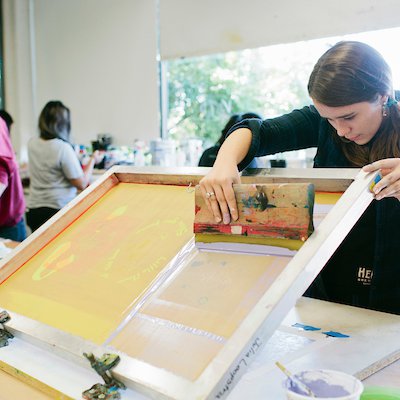The Important Overview to Comprehending Screen Printing and Its Versatile Uses
Screen printing has an abundant history that dates back to old times, advancing right into a sophisticated strategy utilized across various markets today. This guide explores the ins and outs of the screen printing procedure, outlining its applications in fashion, home, and advertising and marketing décor - 10:9 Design Screen Printing Texas. Understanding these basics can open up imaginative capacity for both industrial and imaginative jobs. The adhering to sections will expose necessary pointers and methods to boost one's screen printing endeavors
The Background of Screen Printing
Although screen printing has roots that trace back centuries, its evolution shows the technical and artistic developments of numerous cultures. Stemming in ancient China, the strategy was initially used for embellishing fabrics and later spread to Japan, where it became integral to Ukiyo-e woodblock printing. The approach shifted to Europe in the 18th century, where it gained popularity amongst artisans and business printers. The invention of photo solution in the 20th century revolutionized screen printing, enabling for even more elaborate layouts and higher performance. Artists like Andy Warhol even more drove its popularity, using the tool to create legendary works that combined commercialism and art. By the late 20th century, screen printing had actually established itself as a functional technique, employed in vogue, marketing, and art. Today, it remains to advance, incorporating electronic technology and expanding its applications across various markets.
The Screen Printing Process Explained
Screen printing transforms creative visions into concrete styles via a series of specific actions. An image is developed and after that moved onto a screen, normally made of fine mesh textile extended over a framework. A light-sensitive emulsion is used to the screen, which is subjected to light, hardening in locations not covered by the picture. After rinsing the unhardened solution, a stencil is developed.
Next, the screen is placed over the substrate, whether it be textile, paper, or an additional material. Ink is after that pushed with the open locations of the stencil utilizing a squeegee, depositing the design onto the substratum below. This procedure can be repeated for multiple colors, calling for different screens for every tone. The published thing is treated utilizing warmth to ensure the ink sticks appropriately, resulting in a long lasting, dynamic design all set for use.
Sorts Of Screen Printing Techniques

In addition, specialized strategies, such as discharge screen printing, remove color from the material to produce softer prints, while foil screen printing uses metallic foil to accomplish a glossy surface (10:9 Design Company). Each method supplies unique characteristics, satisfying numerous imaginative demands and production ranges, inevitably expanding the opportunities within the screen printing domain name
Applications of Screen Printing in Various Industries

Additionally, the signage and advertising and marketing fields use screen printing for developing attractive display screens and banners. This technique permits for strong shades and detailed designs that record interest. In electronic devices, screen printing is utilized for applying conductive inks to motherboard, necessary for element links. Moreover, the home design sector accepts screen printing to produce distinct designs on fabrics and wall surface art. On the whole, screen printing works as an essential tool across diverse areas, boosting products her explanation with customized and aesthetically attractive graphics.
Tips for Effective Screen Printing Projects
While taking on a screen printing project, cautious focus to information can significantly boost the last result. Initially, choosing top quality materials is essential; this consists of the screen, inks, and substrates. Making use of proper mesh counts can impact ink deposition and information resolution. Preparation is similarly essential; extensive cleaning of displays and proper direct exposure times ensure crisp prints.
Next, exact enrollment is crucial for multi-color prints. Making use of alignment tools can aid attain accurate layering. Furthermore, screening prints on scrap products prior to production aids recognize potential issues without wasting resources.

Frequently Asked Concerns
What Materials Are Best for Screen Printing on Material?
Cotton and polyester blends are perfect for screen printing on fabric because of their toughness and ink absorption. Furthermore, specialty materials like silk or canvas can generate one-of-a-kind structures and finishes, improving the total design top quality.
Exactly how Do I Clean and Maintain Screen Printing Devices?
To preserve and clean screen printing tools, one should consistently clean displays with suitable solvents, inspect squeegees for wear, lube relocating components, and store all products in a dry, dust-free setting to lengthen their lifespan.
What Are the Ecological Impacts of Screen Printing?
Screen printing can have significant environmental impacts, including chemical waste from inks and solvents, water usage throughout cleaning procedures, and power intake. Lasting methods and environmentally friendly products are important for lessening these negative effects.
Can Screen Printing Be Done in your home Efficiently?
Screen printing can be efficiently done at home with the right products and techniques. Enthusiasts can create top quality prints, though success relies on their skill degree, devices, and understanding of the process included.
What Are the Expenses Connected With Starting a Screen Printing Organization?

Beginning a screen printing service involves costs for devices, products, and work area. First expenditures commonly vary from a few hundred to a number of thousand bucks, depending upon the range, high quality of equipment, and wanted production capacity.
Screen printing has an abundant background that dates back to old times, progressing into a sophisticated strategy used throughout numerous markets today. Another strategy, rotating screen printing, utilizes cylindrical screens, assisting in continual printing on material rolls, consequently enhancing performance for large manufacturings. In addition, specialized techniques, such as discharge screen printing, eliminate color from the textile to this content develop softer prints, while aluminum foil screen printing uses metal foil to achieve a glossy finish. In the style sector, screen printing is extensively utilized to produce vivid layouts on garments, allowing brand names to showcase their one-of-a-kind designs. Cotton and polyester blends are suitable for screen printing on fabric due to their resilience and ink absorption.